Context Specific Strategies for Conserving Biodiversity In Agricultural Land
The study compares biodiversity loss due to agriculture in various contexts, including plant communities and local landscapes. Biodiversity loss varies according to plant type and landscape context, with primary vegetation experiencing less loss than croplands. Geographic factors also influence these findings. Future research should reanalyze data by sub-regions within tropical and subtropical areas and extend of adoption of sustainable practices to clarify the relationship between biodiversity loss and farming methods.
Citation: The Following Is An Unpublished ‘News And Views’ Style Discussion Written By Me About “Ceaușu, S., Leclère, D. & Newbold, T. Geography and availability of natural habitat determine whether cropland intensification or expansion is more detrimental to biodiversity. Nat Ecol Evol (2025). https://doi.org/10.1038/s41559-025-02691-x” for general audience.
Contents
- TITLE
- KEYWORDS
- SUMMARY
- INTRODUCTION
4.1 The Need for a Comprehensive National Strategy
4.2 Comprehensive Assessment of Biodiversity Loss
4.3 Expansion and Conservation Challenges
4.4 Threats to Tropical and Aquatic Ecosystems
4.5 Invasive Species and Change
4.6 Urbanization and Infrastructure Development
4.7 Global Initiatives, Ecosystem Benefits, and Human Welfare - RESEARCH DESIGN AND EVALUATION (AKA PHILOSOPHY OF SCIENCE OR SCIENTIFIC METHOD)
5.1 Table
5.2 Brief Report - METHODS
6.1 Key Databases and Their Contributions
6.2 Methodology: Utilizing the PREDICTS database for assessing agriculture and biodiversity - RESULTS
- DISCUSSION
8.1 Addressing Global Biodiversity Loss: The Challenge of Conservation in Landscape Contexts
8.2 Geographic Context and Biodiversity Dynamics
8.3 The Impact of Climate Change on Biodiversity and Ecological Processes
8.4 Integrating Biodiversity with Economic Frameworks
8.5 Strategies for Biodiversity Conservation
8.6 The Role of Ecotourism and Traditional Farming
8.8 Charles Darwin and ‘Origin Of Species’ – his way of saying ‘Circle Of Life’ quote Lion King song by Sir Elton John - REFERENCES
1. TITLE
Context Specific Strategies for Conserving Biodiversity In Agricultural Land: Opportunities for Sustainable Development of Ecology, Economy and Human Health
2. KEYWORDS
PREDICTS database, land-use conversion strategies, primary vegetation, croplands, essential ecological metrics, intensification, agricultural efficiency, conservation objectives, sensitivity testing, crop types (maize, soybean, wheat, rice), global parameter values, yield increases, incremental production gains.
3. SUMMARY
Observation: The alarming decline of wildlife populations—encompassing mammals, birds, amphibians, reptiles, and fish—revealed in the World Wildlife Fund’s Living Planet Report (LPR) 2022, indicates an average drop of 69% since 1970. This stark reality underscores the urgent need for a comprehensive national strategy focused on farmland biodiversity, especially because biodiversity and human health are closely related. Aim: This study seeks to compare biodiversity loss due to agriculture by examining various contexts, including plant communities, local landscapes, and global climate zones, with a focus on natural versus human-modified areas. Methods: Biodiversity was assessed using species richness, total abundance, and RCAR. Datasets from PREDICTS, EarthStat, and MapSPAM were utilized to model biodiversity loss and its causes. Results: Biodiversity loss varies according to plant type and landscape context, with primary vegetation experiencing less loss than croplands. Geographic factors, particularly the distinction between tropical and non-tropical regions, influence these findings. Future Directions: The absence of clear trends in biodiversity loss concerning crop type, intensive farming, and land expansion in tropical and non-tropical regions suggests that other variables may impact biodiversity. Reanalyzing data by sub-regions within tropical and subtropical areas, along with extend of adoption of sustainable practices, may clarify the relationship between biodiversity loss and farming methods.
4. INTRODUCTION
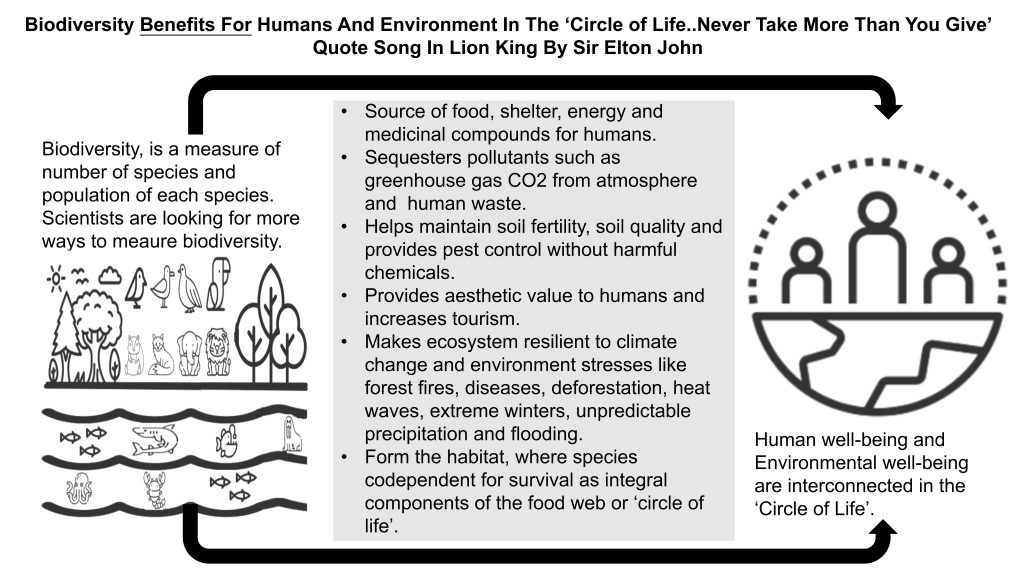
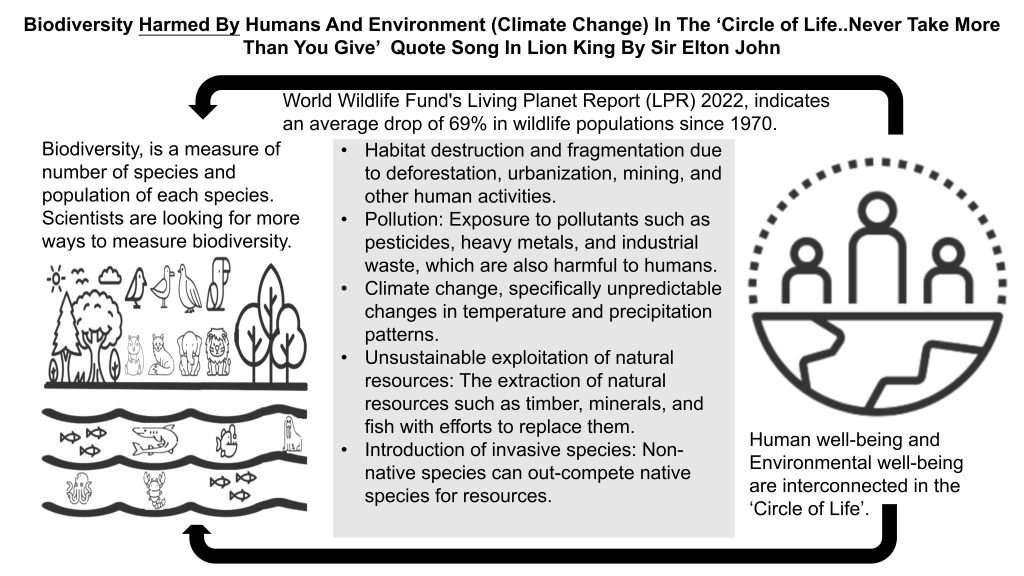
4.1 The Need for a Comprehensive National Strategy
The alarming decline of wildlife populations—encompassing mammals, birds, amphibians, reptiles, and fish—revealed in the World Wildlife Fund’s Living Planet Report (LPR) 2022, indicates an average drop of 69% since 1970. This stark reality underscores the urgent need for a comprehensive national strategy focused on farmland biodiversity, especially because biodiversity and human health are closely related. Such a strategy must integrate policy frameworks and research initiatives aimed at preserving ecosystems and traditional agricultural knowledge, aligning with the post-2020 biodiversity targets established by the Convention on Biological Diversity (CBD). This approach should not solely prioritize the protection of existing habitats, but also actively promote sustainable agricultural practices that enhance biodiversity, including agroecology, permaculture, and organic farming. Collaboration among government agencies, the agricultural sector, and environmental organizations is essential for developing policies that incentivize biodiversity-friendly practices among farmers. Furthermore, the role of citizen science data is critical; it highlights the importance of unprotected agricultural landscapes in supporting bird populations, thereby demonstrating the necessity for conservation efforts to extend beyond designated protected areas. This data can guide land management decisions by identifying priority areas for immediate conservation or restoration. Engaging local communities and stakeholders in conservation initiatives is vital; they offer invaluable insights into local ecosystems and significantly contribute to monitoring biodiversity changes. By incorporating traditional agricultural knowledge into contemporary practices, we can bolster the resilience of ecosystems and advance sustainable food production. Educational programs emphasizing biodiversity conservation in agricultural contexts will empower future generations to advocate for and actively participate in the preservation of their natural heritage. As we strive to meet the CBD’s targets, it is critical to recognize that farmland biodiversity is not merely an environmental concern; it is intricately linked to food security, rural livelihoods, and climate resilience, emphasizing the necessity of a comprehensive strategy. By integrating ecological, economic, and social dimensions into a cohesive framework, we can work towards a sustainable future for both biodiversity and agricultural communities.
4.2 Comprehensive Assessment of Biodiversity Loss
Understanding the multifaceted impacts of biodiversity loss in agricultural landscapes necessitates a comprehensive assessment that accounts for land conversion, species abundance, and biotic homogenization across different regions. Land conversion, often fueled by agricultural expansion, urban development, and infrastructure projects, fundamentally alters ecosystems, causing fragmentation and habitat degradation. Such transformations lead to declines in species richness, particularly among those species that require specific habitat conditions to thrive. The relationship between yield increases and biodiversity is complex; while higher yields may indicate enhanced agricultural productivity, they typically come at the expense of adjacent natural areas, resulting in reduced habitat availability and altered ecological dynamics. The impact of modern farming practices on biodiversity exhibits significant variability depending on crop type and habitat cover. For example, monocultures—predominant in extensive agricultural areas—often lead to lower species diversity compared to polyculture systems, which nurture a range of crops. Conversely, practices such as the integration of cover crops and conservation tillage can alleviate some of the negative effects on biodiversity by promoting healthier soils and providing habitats for beneficial organisms. A robust assessment of biodiversity loss must employ a range of metrics, including species richness (the variety of different species in a given area), total abundance (the overall number of individuals across species), and measures of biotic homogenization (the convergence of local biological communities). These metrics facilitate the quantification of biodiversity changes and elucidate how agricultural practices impact ecological health. For instance, studies in specific regions may reveal substantial declines in both richness and abundance of native pollinator species—key to the pollination of numerous crops—due to intensive farming practices. Additionally, regional variations must also be factored in, as biodiversity loss can differ markedly from one geographic area to another; regions characterized by high agricultural intensity are likely to witness sharper biodiversity declines than those with more balanced land-use practices. Through the application of advanced ecological modeling, remote sensing technologies, and participatory assessments that engage local communities, researchers can construct a clearer understanding of the extent and drivers of biodiversity loss in agricultural systems. This knowledge is pivotal for informing conservation strategies and policy frameworks aimed at restoring and maintaining biodiversity in agricultural landscapes, ultimately contributing to resilient, sustainable food systems in the face of climate change.
4.3 Expansion and Conservation Challenges
Global trends indicate a troubling encroachment of agricultural cropland upon high-quality forests and protected areas, necessitating the implementation of stronger land-use policies that effectively reconcile conservation with sustainable agriculture. Regions of unique ecological significance, such as mountainous areas like Mount Kilimanjaro, are particularly vulnerable to these pressures. The intricate interconnections between elevation, temperature variability, and biodiversity risk severe functional changes in ecosystems, highlighting the urgent need for integrated land management strategies that holistically consider environmental and agricultural contexts. Urban areas represent a unique set of conservation challenges. Although European cities are hubs of human activity and culture, they harbor increasingly evolutionarily distinct bird communities that are vital for maintaining urban biodiversity. As urbanization accelerates, the strain on these habitats intensifies, leading to habitat fragmentation that disrupts critical ecological networks necessary for species survival. Moreover, urban expansion can compromise essential ecosystem services such as clean air, water filtration, and recreational spaces, which are integral to urban residents’ quality of life. The ramifications of rapid urban growth are starkly illustrated in regions like Guangdong Province, where city expansion displaces natural habitats, resulting in exacerbated biodiversity loss and diminished ecosystem resilience. To address these challenges, initiatives prioritizing urban planning that integrates green spaces, wildlife corridors, and sustainable infrastructure are essential. Strategies such as the implementation of urban forests, green roofs, and community gardens can enhance habitat connectivity, support local species, and offer recreational benefits to residents. Effective conservation practices must also incorporate innovative conservation measures that blend local knowledge with scientific research. Engaging local communities in conservation efforts fosters stewardship and raises awareness of biodiversity’s importance. Furthermore, aligning agricultural policies with climate adaptation strategies is crucial; practices that enhance both crop resilience and biodiversity must be included to mitigate impending climate impacts. Techniques including crop rotation, agroforestry, and the integration of native plant species within agricultural systems can improve soil health while simultaneously creating habitats for beneficial wildlife. In summary, navigating the dual challenges of expansion and conservation will require a multifaceted approach that harmonizes human development with biodiversity preservation. By fostering stakeholder collaboration, leveraging local knowledge, and employing adaptive management strategies, we can cultivate resilient ecosystems that support both agricultural productivity and ecological integrity, thereby ensuring a sustainable balance for future generations.
4.4 Threats to Tropical and Aquatic Ecosystems
Tropical deforestation, driven by artisanal mining and agricultural expansion, presents a significant threat to fragile ecosystems, such as those in Ethiopia’s Songnen Plain and the Atlantic Forest. These destructive activities not only peril native flora and fauna but also lead to increased soil erosion and carbon emissions, thereby exacerbating climate change. Predictive models suggest that if current trends persist, species populations will continue to decline, underscoring the urgent necessity for proactive conservation measures. Aquatic ecosystems, including Dongting Lake and the Li River Basin, face similar challenges from human activities that generate nutrient runoff from land use, habitat fragmentation, and urbanization. These factors drastically reduce macroinvertebrate diversity, which is crucial for maintaining water quality and fundamental ecosystem services like nutrient cycling and energy transfer within aquatic food webs. Implementing landscape planning grounded in ecological principles is paramount for safeguarding these vital ecosystems in the face of mounting pressures. Invasive species also pose a significant threat by disrupting native ecosystems and filling new niches that facilitate their spread. For instance, invasive insects and earthworms can homogenize soil microbial communities, which diminishes functional diversity and alters essential nutrient cycles, jeopardizing ecosystem health. The introduction of non-native organisms can shift local ecosystems’ balance, diminishing their resilience to environmental changes. Climate change adds further complexity, as shifts in temperature and precipitation patterns can accelerate the spread of invasive species while altering competitive dynamics among native organisms. The vulnerability of ecosystems, such as the African snowpack in the Alps to climate fluctuations, exemplifies the detrimental effects of these changes on local biodiversity. Additionally, drought conditions adversely impact crops like sugarcane, underlining the interconnectedness of agricultural systems and climate resilience. This scenario emphasizes the pressing need for adaptive management approaches capable of anticipating and responding to these rapidly evolving conditions.
4.5 Invasive Species and Change
The influence of invasive species on biodiversity is particularly pronounced in the context of land-use change. As natural habitats undergo alteration, the risk of invasion escalates, thereby necessitating proactive measures in both invasion ecology and landscape planning. Understanding empirical frameworks, such as Darwin’s naturalization hypothesis, clarifies mechanisms through which invasive species expand their ranges in tandem with climate change and human-induced landscape modifications. Implementing effective management programs focused on early detection and rapid response is essential to minimizing invasive species’ impacts and restoring ecological balance. Collaborative efforts among scientists, land planners, and local communities are vital to developing integrated approaches that address the dual challenges of invasive species proliferation and habitat degradation. By prioritizing native species and ecosystem integrity, we can foster environments that support biodiversity amid ongoing environmental change.
4.6 Urbanization and Infrastructure Development
The expansion of urban areas and infrastructure development continues to pose substantial threats to biodiversity through habitat fragmentation, environmental filtering, and biotic homogenization. As cities grow, natural habitats frequently become divided into smaller, isolated patches, which diminishes genetic diversity and obstructs wildlife movement. This fragmentation not only hampers species thriving but also disrupts ecosystem functions such as pollination and pest regulation, complicating conservation efforts. Innovative urban planning and land-use policies that prioritize biodiversity are crucial for mitigating these negative impacts. Approaches that incorporate green corridors, urban forests, and wildlife habitats into city designs can enhance habitat connectivity and bolster biodiversity. Sustainable development policies that embrace green spaces and integrate ecological considerations into urban infrastructure projects are essential for fostering resilience in urban environments. Moreover, community engagement plays a significant role in advancing effective urban biodiversity strategies. Educating residents on the importance of local biodiversity and involving them in conservation initiatives can cultivate a sense of stewardship and responsibility. By facilitating collaboration among stakeholders—including city planners, conservationists, and local communities—we can devise comprehensive strategies that balance urban growth with ecological preservation. Collectively addressing these threats through informed and inclusive planning will pave the way for sustainable ecosystems that flourish alongside human development, thus creating a harmonious relationship between urban expansion and natural diversity.
4.7 Global Initiatives, Ecosystem Benefits, and Human Welfare
The global “30×30” initiative aims to protect 30% of the world’s land by 2030, and its success will depend on strategic, coordinated efforts that could potentially safeguard up to 65% of at-risk species, surpassing region-specific approaches. The Framework for Biodiversity Conservation highlights the health benefits associated with interaction with natural environments, supporting immune function and reducing allergies, thus establishing a direct connection between biodiversity preservation and human well-being. Marine Protected Areas (MPAs) are vital for conserving marine biodiversity while simultaneously supporting local livelihoods. The integration of advanced technologies, such as Mixed Reality, enhances management and decision-making processes for conservation efforts. Nevertheless, despite ongoing restoration initiatives, habitat degradation remains persistent, as evidenced in regions such as Zhongwei, China. Across continents, including Africa, South America, Asia, the Middle East, and Central America, biodiversity continues to face threats posed by inadequate public awareness and infrastructure projects, such as dam construction, jeopardizing river ecosystems, endangered freshwater species, and local communities. This situation underscores the importance of implementing basin-wide safeguards and sustainable development policies aimed at mitigating biodiversity loss and its associated economic consequences.
5. RESEARCH DESIGN AND EVALUATION (AKA PHILOSOPHY OF SCIENCE OR SCIENTIFIC METHOD)
5.1 Table
| Observation | The decline of wildlife populations, including mammals, birds, amphibians, reptiles, and fish, as revealed in the World Wildlife Fund’s Living Planet Report (LPR) 2022, indicates an average drop of 69% since 1970. |
| Hypothesis | Biodiversity loss due to agriculture varies according to plant type and landscape context, with primary vegetation experiencing less loss than croplands. Geographic factors also influence these findings. |
| Experiment | Biodiversity was assessed using species richness, total abundance, and RCAR. Datasets from PREDICTS, EarthStat, and MapSPAM were utilized to model biodiversity loss and its causes. |
| Result | Biodiversity loss varies according to plant type and landscape context, with primary vegetation experiencing less loss than croplands. Geographic factors, particularly the distinction between tropical and non-tropical regions, influence these findings. |
| Inference | Biodiversity loss varies depending on the type of plant and landscape context, with primary vegetation experiencing less loss than croplands. Geographic factors such as tropical and non-tropical regions also influence these findings. However, there is no clear trend in biodiversity loss concerning crop type, intensive farming, and land expansion in both tropical and non-tropical regions. The text suggests that other variables may impact biodiversity, and reanalyzing data by sub-regions within tropical and subtropical areas, along with the adoption of sustainable practices, may clarify the relationship between biodiversity loss and farming methods. |
5.2 Brief Report
Observation: The alarming decline of wildlife populations—encompassing mammals, birds, amphibians, reptiles, and fish—revealed in the World Wildlife Fund’s Living Planet Report (LPR) 2022, indicates an average drop of 69% since 1970. This stark reality underscores the urgent need for a comprehensive national strategy focused on farmland biodiversity, especially because biodiversity and human health are closely related.
Aim: The overall goal of This study aimed to compare the loss of biodiversity (loss of plant and animal species) due to agriculture. To do this, loss of biodiversity was compared in different contexts (communities) relative to peak biodiversity (species well-being) in the context of completely natural vegetation where no human interference has occurred. The different contexts from the perspective of species are the different communities in which they live, not only the plants themselves but also the animals around them. The different contexts from the perspective of the species are as follows.
a) plant type or direct community of plants where the species are living ‘analogous to home’: naturally occurring plants, that is primary vegetation vs. human planted crops, that is croplands.
b) Local landscape type or indirect surrounding community of plants ‘analogous to neighborhood’: natural areas, that is, natural landscapes like primary vegetation or human modified areas, that is, modified landscapes like croplands.
c) Global landscape type or indirect surrounding community of plants ‘analogous to distant place away from neighborhood’: tropical and non-tropical climate zones with different extents of natural areas like primary vegetation and different extents of human-modified areas like croplands. In the context of croplands, at the global scale, further stratification occurs, as there are differences in the type of crops grown globally, such as rice and maize, and extend of human modification for increasing crop production with regard to cropland expansion and yield increasing intensive farming, such as chemical fertilizers and organic fertilizers.
Methods: Biodiversity was measured using three metrics: species richness, total abundance, and RCAR, an indicator of biotic homogenization. Biotic homogenization is a phenomenon in which ecological communities become increasingly similar across space, often as a result of human impact, leading to a loss of biodiversity and an increase in extinction risk for some species. The biodiversity dataset was obtained from PREDICTS, whereas agricultural datasets were obtained from the EarthStat and MapSPAM databases. These datasets were then used to model and build a stimulation and prediction framework to study potential cause-and-effect relationships between the loss of biodiversity and groups in the context of a, b, and c described above.
Results:
(Figure. 2 of paper) In the context of a) plant type, primary vegetation or natural plant communities had 0–11% loss of biodiversity compared to 25–45% loss of biodiversity in crop plant communities or croplands.
For landscape context b), this study found a significant dependence of biodiversity loss on landscape type in the context of different plant types a). The findings indicate a predicted average biodiversity loss of 11% in primary vegetation surrounded by natural areas, biodiversity loss of 25% in croplands surrounded by natural areas, and biodiversity losses of 40% in croplands surrounded by human-modified areas.
(Figure. 2) For the global context c), the findings of this study are limited. There is a significant geographical effect in that there is a 40% loss of biodiversity (abundance metric) in primary vegetation surrounded by human-modified areas in non-tropical regions but not in tropical regions. For cropland surrounded by human modified areas there is 40% and 50% loss of biodiversity in tropical and non-tropical regions, respectively. This finding highlights the importance of considering the local context when assessing the impacts of agriculture on biodiversity.
(Figure. 4 In paper) For global context, this study also compares the loss of biodiversity in agriculture due to two crop production practices:
a) farmland intensification (increasing crops produced per unit of land by intensive farming like irrigation, applying fertilizers on existing farmland) and
b) Farmland expansion (increasing land for producing crops by converting primary vegetation only into croplands, as other types, such as urban areas, into croplands are rare).
For croplands, the study is limited in its finding about the dependence of biodiversity loss on crop type in farmland, farmland intensification (reducing the yield gap), and farmland expansion in the context of geographic regions. In this study, the authors, acknowledge the limitation of the data, analysis and “nuance” quote Ceausu et al. In the comparison of biodiversity in croplands grouped by tropical and non-tropical regions (temperate and subtropical regions), no clear consensus relationship has been established between the loss of biodiversity metrics and region. (Figure. 3) In addition, in the comparison of biodiversity in crop types grouped by tropical and non-tropical regions (temperate and subtropical regions), there is no clear consensus relationship established between the loss of biodiversity metrics and crop type.
Future Direction:
The fact that no cause-effect or clear trend could be established between the stimulus variable (region and/or crop type) and outcome variable (biodiversity or loss or biodiversity) suggests that there are other confounders or variables that strongly mask the relation — problem with data itself, that is, the measure of biodiversity is probably minor because a clear statistically significant relationship was found between biodiversity and landscape. The loss of biodiversity is related to sustainable practices (organic farming and crop rotation). Sustainable practices are not uniformly adapted by all tropical and non-tropical regions. Thus, reanalysis of the data using further separation of tropical and non-tropical regions by regions of developed, developing, and underdeveloped regions, which strongly correlates with adaptation of sustainable practices, may facilitate the determination of the relationship between biodiversity loss and region. Also, separation of non-tropical regions into temperate and sub-tropical regions may further clarify the relationship of climate regions and loss of biodiversity. As RCAR gives results inconsistent with other standard measures of biodiversity, it will be useful to do a through investigation and development of biodiversity metrics. As the results stand, the authors correctly conclude that “neither farmland expansion nor intensification consistently benefits biodiversity” quote Ceausu et al.
6. METHODS
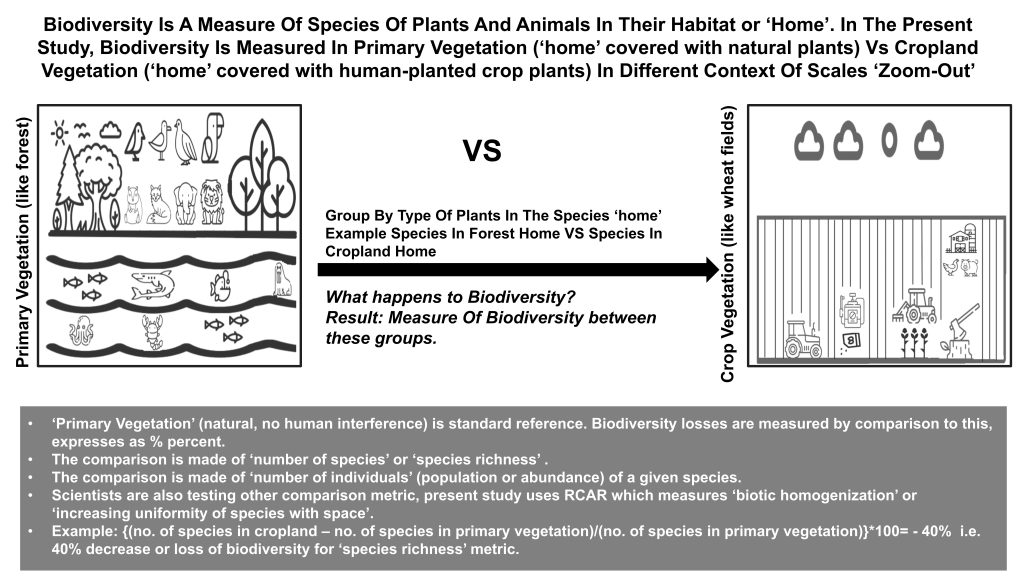
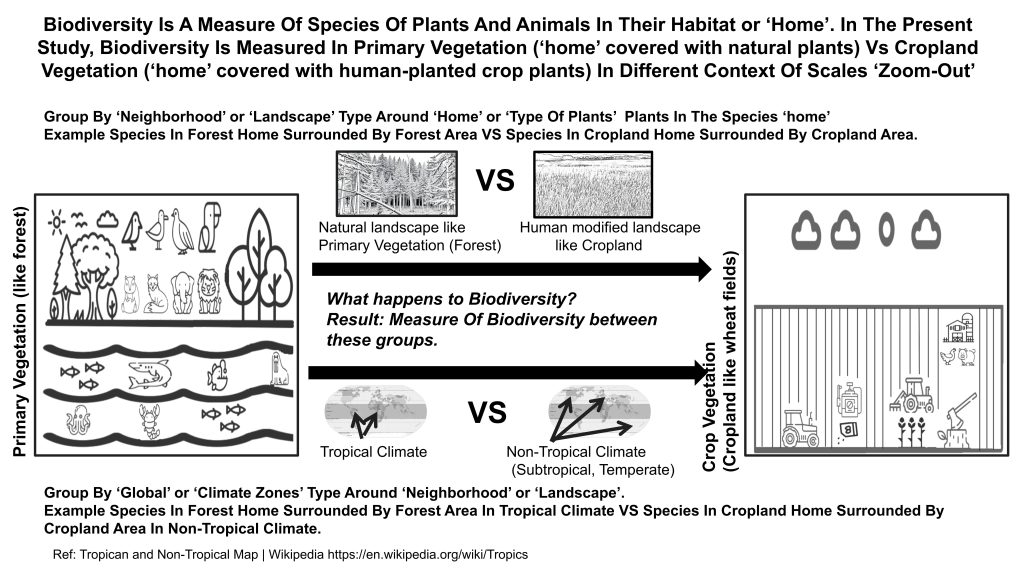
6.1 Key Databases and Their Contributions
The PREDICTS database plays a crucial role in measuring biodiversity through various metrics, such as species abundance, occurrence, and richness, featuring over 1.6 million samples across 78 countries, and encompassing more than 28,000 species. This database evaluates biodiversity responses to human activities and employs the Biodiversity Intactness Index (BII) to estimate the remaining species and their corresponding abundance. Additionally, it systematically details information about sampling sites, taxa, and human land-use pressures.
Complementing this, the Global Biodiversity Information Facility (GBIF) assembles extensive data from natural history museums, citizen science initiatives, and environmental records, documenting over 1.6 billion occurrences of species. It provides standards and tools for effective data sharing, including the Range Change Assessment and Reporting (RCAR) tool, which examines alterations in species distributions as a result of climate change and habitat degradation.
In the realm of agricultural data, resources such as EarthStat and MapSPAM focus on global agricultural systems, leveraging remote sensing, national statistics, and geospatial modeling to address challenges related to food security and climate change.
- EarthStat: This GIS data repository is dedicated to agriculture and environmental analysis. It features the CROPGRIDS dataset, which provides area information for 173 crops as of 2020, at a resolution of 0.05°. By updating the earlier dataset by Monfreda et al. (2008) with recent data from 27 sources, including national statistics from FAOSTAT, EarthStat ensures that data is available in geospatial formats for thorough analysis.
- MapSPAM: This dataset delivers in-depth insights into crop production and yield by utilizing national statistics and remote sensing to spatially disaggregate harvested area data across a gridded cropland map. Similar to EarthStat, it is preserved in geospatial formats for integrated GIS analysis.
Furthermore, the EPIC-BOKU model simulations assess how agricultural systems respond to various management practices. The EPIC model, specifically its BOKU version, simulates subsistence agriculture devoid of fertilization or irrigation at a resolution of 0.5°. This model examines the impact of land management on soil, water quality, and crop yields over extended scenarios, aiding in the evaluation of agricultural suitability under diverse conditions.
6.2 Methodology: Utilizing the PREDICTS database for assessing agriculture and biodiversity
In their study, Silvia Ceausu et al. utilize a comprehensive framework anchored in the PREDICTS database, which serves as a global repository for biodiversity data. This research focuses primarily on two land-use conversion strategies: expanding farmland into previously uncultivated areas (converting primary vegetation only into croplands, as other type like urban areas into cropland is rare), and intensifying agricultural practices within existing croplands. The goal is to assess the impact of these strategies on essential ecological metrics, such as the extent of natural habitats, primary vegetation cover, and land suitability.
The PREDICTS platform offers standardized measures, including species richness (the variety of species present), species abundance (the number of individuals per species), and community composition (the structure of ecosystems). These metrics are founded on extensive ecological studies across various land-use types, providing a solid basis for analyzing ecological outcomes. By leveraging these baseline values, the study maintains consistency in its analyses.
Two primary strategies are examined: the expansion of farmland into new previously uncultivated areas and the intensification of agriculture aimed at enhancing crop yield within existing agricultural spaces. This dual strategy facilitates an exploration of the relationship between land conversion and ecosystem health.
To ensure robustness, the study conducted sensitivity tests examining the influence of assumptions and alternative data sources, thereby validating the reliability of its conclusions. To model future scenarios, global parameter values from the PREDICTS database are applied across the entire landscape. This method allows for yield increases that surpass the documented data, enabling the investigation of more intense scenarios, such as 1%, 5%, and 10% improvements in agricultural output. These figures represent incremental production gains relative to current yields.
The modeling framework considers both land expansion (adding new areas for agriculture) and intensification (boosting productivity without expanding area), permitting an analysis of the trade-offs between agricultural efficiency and conservation objectives.
To validate the robustness of the findings, the experiment includes sensitivity testing that extends beyond PREDICTS’ documented yields. It also investigates various crop types—such as maize, soybean, wheat, and rice—to discern how different agricultural practices impact biodiversity outcomes. This approach identifies situations where intensification yields greater effects than expansion.
By mapping spatial distributions of biodiversity metrics, the study identifies critical habitats that are at risk and aids in determining conservation priorities. The insights garnered from this research assist in prioritizing land-use strategies that foster long-term biodiversity conservation while also maximizing agricultural productivity. Ultimately, the framework facilitates a cause-and-effect analysis of how specific land-use strategies—expansion versus intensification—directly influence biodiversity outcomes. This comprehensive approach highlights the necessity of balancing agricultural productivity with ecological sustainability in land-use practices.
7. RESULTS
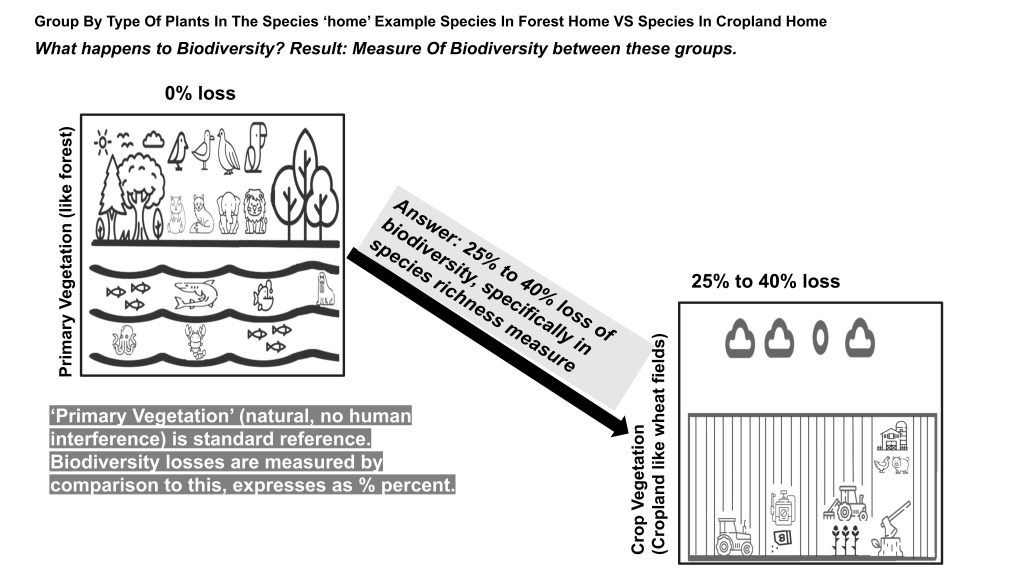
(Figure. 2 of paper) In the context of a) plant type, primary vegetation or natural plant communities had 0 to 11% loss of biodiversity compared to 25% to 45% loss of biodiversity in crop plant communities or croplands.
For landscape context b), the study significantly finds the dependence of biodiversity loss on landscape type in the different plant types context a). The findings indicate a predicted average biodiversity loss of 11% in primary vegetation surrounded by natural areas, biodiversity loss of 25% in croplands surrounded by natural area and biodiversity losses of 40% in croplands surrounded by human modified areas. This suggests that different types of plants, namely natural wild plants vs human cultivated crops, have varying levels of sensitivity to human-driven landscape modifications, with some being more resilient than others.
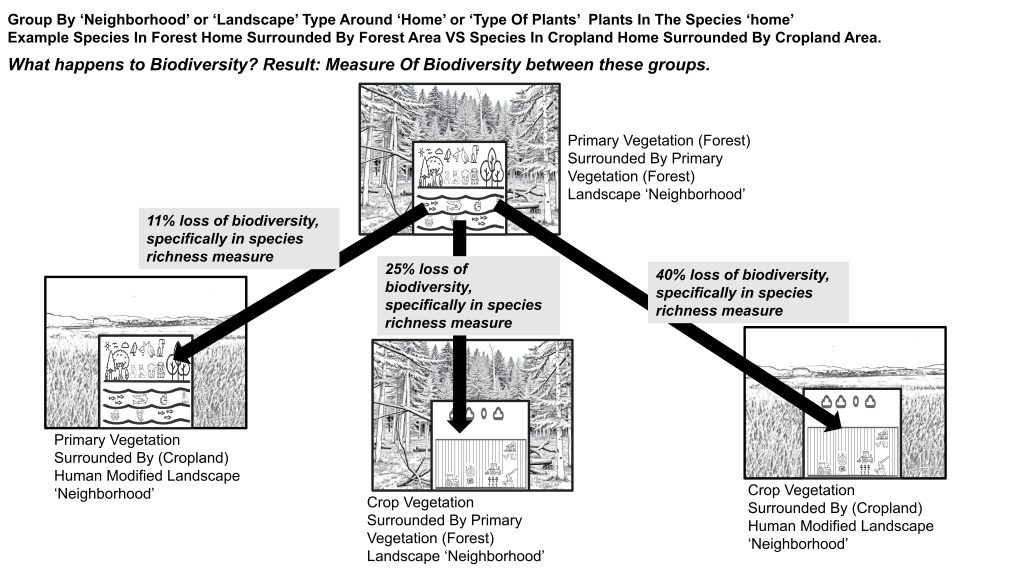
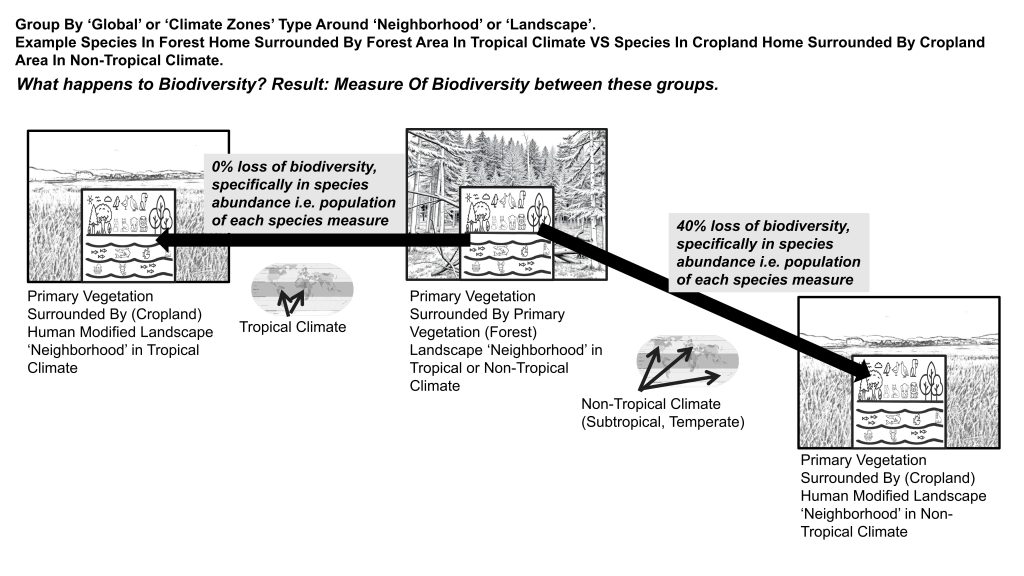
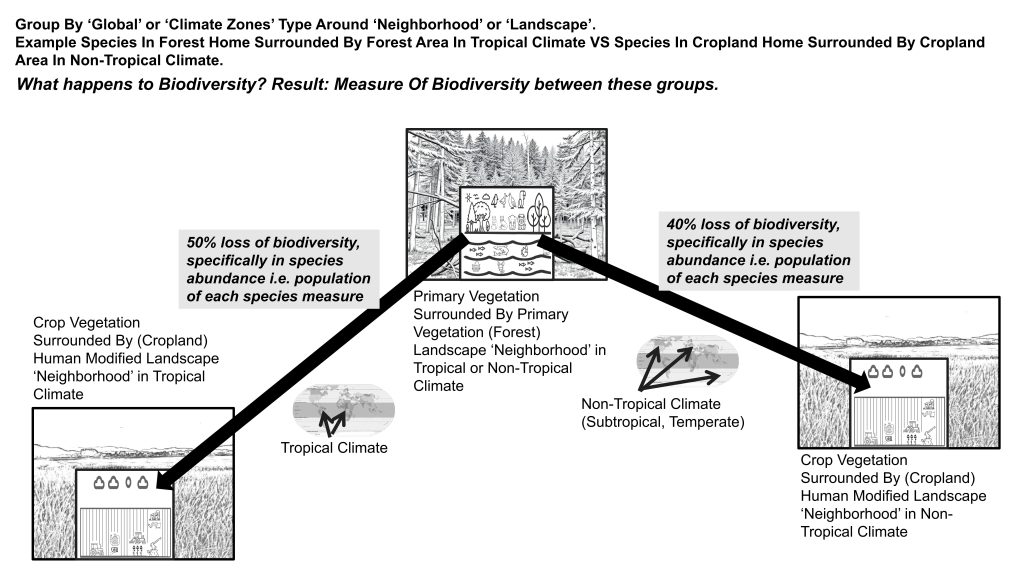
(Figure. 2 of paper) For global context c), the finding of the study are limited. There is significant geographical effect, in that there is a 40% loss of biodiversity (abundance metric) in primary vegetation surrounded by human modified areas in non-tropical regions but not in tropical regions. This suggests that biodiversity abundance in primary vegetation in non-tropical regions is more dependent on the surrounding natural landscape than in tropical regions. However, for cropland surrounded by human modified areas there is 40% and 50% loss of biodiversity in tropical and non-tropical regions, respectively. This finding highlights the importance of considering the local context when assessing the impacts of agriculture on biodiversity. For biodiversity in cropland surrounded by natural landscape in tropical regions, one biodiversity metric is significantly down (abundance) and another is significantly down up (RCAR), which makes the result inconclusive.
(Figure. 4 of paper) For global context, this study also compares loss of biodiversity in agriculture due to two crop production practices:
a) farmland intensification (increasing crops produced per unit of land by intensive farming like irrigation, applying fertilizers on existing farmland) and
b) farmland expansion (increasing land for producing crops by converting primary vegetation only into croplands, as other type like urban areas into cropland is rare).
(Figure. 3 of paper) Also, in the comparison of biodiversity in crop types, grouped by tropical and non-tropical regions (temperate and subtropical regions) there is no clear consensus relationship established between loss of biodiversity metrics and crop type.
The inconclusive results were, as follows:
- “Yield increases were associated with decreases in species richness (Fig. 3a,c,d) with two exceptions: landscapes with soybean cultivation, where soybean yield increases were not associated with any changes in species richness (Fig. 3b); and landscapes with rice cultivation and high percentage of natural vegetation, where rice yield increases were associated with increases in species richness (Fig. 3d). The association between yield increases and total abundance is more complex (Fig. 3e–h), the interaction with geographic region becoming important to explain abundance patterns within landscapes with maize, soybean and rice cultivation (Fig. 3e,f,h, respectively).” quote Ceausu et al
- “For non-tropical regions, closing yield gaps leads to negative species richness and abundance effects but positive effects in terms of RCAR (Fig. 4). For tropical regions, the effects in terms of species richness are both positive and negative depending on location, whereas the effects on total abundance are positive and the effects on RCAR are negative (Fig. 4).” quote Ceausu et al
- “When comparing hypothetical options for increasing total production by 1% in existing agricultural landscapes, neither expansion nor intensification had better estimated biodiversity outcomes in all locations (Fig. 5). Intensification was associated with better biodiversity outcomes in terms of species richness than farmland expansion on 29%, 83.3%, 64.2% and 56.7% of the cultivated areas for maize, soybean, wheat and rice, respectively (Fig. 5a–d). Farmland expansion was associated with higher species richness on the rest of the cultivated areas.” quote Ceausu et al
Here the study is limited in its finding about the dependence of biodiversity loss on crop type in farmland, farmland intensification (reducing yield gap), farmland expansion in context of geographic regions. In this study, the authors, acknowledge the limitation of the data, analysis and “nuance” quote Ceausu et al. In the comparison biodiversity in croplands grouped by tropical and non-tropical regions (temperate and subtropical regions), there is no clear consensus relationship established between loss of biodiversity metrics and region. It’s important to note that while these findings suggest some level of uncertainty in the impacts of agriculture on biodiversity in tropical regions, they also highlight the need for further research to better understand these complex relationships. By examining different metrics and contexts, we can gain a more comprehensive understanding of how land conversion affects biodiversity and develop strategies that are tailored to specific situations. Overall, this study underscores the importance of considering the local context when assessing the impacts of agriculture on biodiversity. By taking into account factors such as geography, habitat preferences, and yield increases, we can make more informed decisions about how to promote sustainable development while also protecting biodiversity.
8. DISCUSSION
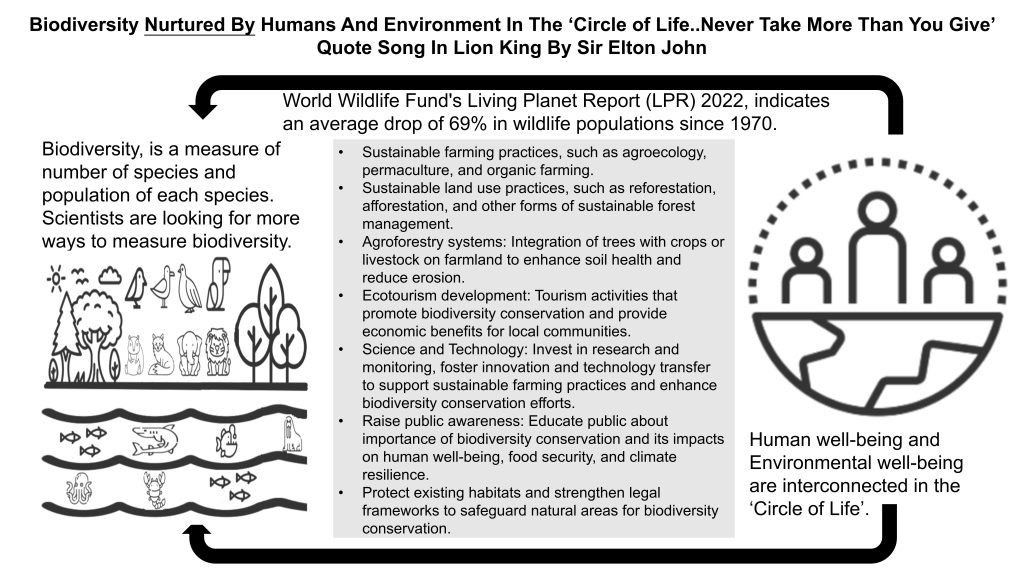
8.1 Addressing Global Biodiversity Loss: The Challenge of Conservation in Landscape Contexts
The pressing issue of global biodiversity loss necessitates a multifaceted approach that combines effective land management, strategic policy development, and rigorous ecological research. Findings from the present study by Ceausu et al here, indicate, both primary vegetation situated within minimally modified landscapes (less than 30% human alteration) and those surrounded by highly modified landscapes (over 70% human alteration) exhibit significant biodiversity richness.
8.2 Geographic Context and Biodiversity Dynamics
To maximize the efficacy of land-use strategies and habitat management initiatives, it is essential to further elucidate the relationship between geography and biodiversity. There is significant geographical effect, in that there is loss of biodiversity (abundance metric) in primary vegetation surrounded by human modified areas in non-tropical regions but not in tropical regions. The findings suggest that biodiversity abundance in primary vegetation in non-tropical regions may be more dependent on surrounding natural landscape than tropical regions. However, this significance does not hold true for all three biodiversity metrics, and infact for biodiversity in cropland surrounded by natural landscape in tropical regions, one biodiversity metric is significantly down (abundance) and another is significantly down up (RCAR).
Findings from the present study by Ceausu et al here, does not clearly extract the relationship between expansion of cropland area and loss of biodiversity, and agricultural intensification (efforts to reduce yield gaps) and loss of biodiversity within croplands. However, the connection between biodiversity loss and geographical context, particularly when distinguishing between tropical and non-tropical regions, is often complex and not straightforward. The study Ceausu et al is a great start that highlights additional factors that need to normalized out (such as with PCA analysis or surrogate variable adjustment) or defined into the model as stimulus or independent variables, to extract the relationship between crop types and regional classification or geography with biodiversity. The authors of this study acknowledge the inherent limitations of their data analysis and the potential impact of confounding variables that may obscure the relationship between regional or crop-specific factors and biodiversity loss. A reexamination of the data, with a more granular breakdown of tropical and non-tropical regions by additional climate zones (sub-tropical and temperate) and country development status (developed, developing or underdeveloped), could provide deeper insights into these dynamics [Also see ‘Future Directions’ section].
8.3 The Impact of Climate Change on Biodiversity and Ecological Processes
The ongoing effects of climate change on species distributions and ecological functioning highlight the urgent necessity for adaptive management strategies in conservation. Innovative approaches such as rewilding and wetland restoration present viable options for enhancing ecosystem resilience, thereby mitigating the adverse impacts of climate change. Specifically, restoration techniques, which include rewilding previously abandoned farmland and rehabilitating wetland areas, frequently offer more sustainable solutions for confronting the dual crises of climate change and biodiversity loss than traditional afforestation methods—especially in regions characterized by high species diversity.
8.4 Integrating Biodiversity with Economic Frameworks
Incorporating biodiversity considerations into economic frameworks, such as natural capital accounting, significantly improves sustainable land-use planning. This integration is essential for achieving a delicate balance between food security, climate mitigation, and conservation objectives. Within the paradigm of sustainable intensification—which seeks to enhance food production without aggravating ecological degradation—there remains a notable gap in targeted research that promotes sustainable agricultural practices. The naturalization of alien plant species illustrates distinct latitudinal gradients influenced by climatic conditions and human land use. Evidence from over 487 regions suggests that alien species in higher latitudes tend to share closer phylogenetic ties with native species, likely due to their adaptation to harsher environmental conditions. Human-driven landscape alterations also facilitate species invasions, especially in warmer and drier regions, underscoring the necessity for targeted interventions.
8.5 Strategies for Biodiversity Conservation
Addressing biodiversity loss effectively requires a multifaceted strategy that includes sustainable water governance, robust climate adaptation initiatives, and the establishment of comprehensive international legal frameworks. Merging operational biodiversity theory with diverse agricultural practices can fortify overall sustainability, enhancing food security and climate resilience across multiple sectors. While many conservation initiatives prioritize the protection of visible, above-ground species, it is crucial to acknowledge and incorporate below-ground life forms when designing conservation areas. Current carbon conservation strategies have often overlooked numerous species within some of the planet’s most biodiverse tropical forests, emphasizing the urgent need to integrate biodiversity considerations into carbon conservation planning.
8.6 The Role of Ecotourism and Traditional Farming
While ecotourism has the potential to drive economic growth, it can also impose additional pressures on ecological systems. Therefore, careful management of tourist capacities and increased investment in ecological restoration are essential for sustainable practices. Small reserves can play a pivotal role in conservation efforts, acting not only as habitats but also as facilitators of increased connectivity within landscapes. Additionally, traditional farming systems, such as olive groves, contribute significantly to biodiversity by fostering heterogeneous landscapes that maintain ecological connectivity. Emphasizing and leveraging such traditional practices can enhance the effectiveness of conservation goals in contemporary contexts.
8.7 The Benefits of Organic Farming to Human Health and Biodiversity
Research indicates that organic farms typically support up to 34% more biodiversity than their conventional counterparts, including a greater abundance of both flora and fauna. Natural fertilizers used in organic farming, such as compost and manure, contribute to the enhancement of soil organic matter and structure, promoting better water retention and minimizing erosion. Furthermore, organic systems typically utilize substantially fewer external inputs and forego synthetic chemical fertilizers, pesticides, genetically modified organisms, and pharmaceuticals. Although organic farming permits the use of natural pesticides, precautions remain necessary, as these can still leave residues on produce. In addition, organic farming can mitigate climate change by sequestering more carbon in the soil and reducing greenhouse gas emissions in comparison to conventional practices. For example, organic farms consume 45% less energy than conventional farms, and eliminating synthetic nitrogen fertilizers could potentially reduce direct global agricultural greenhouse gas emissions by approximately 20%. Organic practices also help curtail nutrient losses to waterways and air, which is a step toward diminishing water pollution and reducing emissions of harmful gases such as ammonia and nitrous oxide. Nutrient surpluses from conventional farming often lead to eutrophication, hypoxia, and harmful algal blooms, which pose serious threats to aquatic life and human health. By implementing organic principles—including crop rotation and the use of natural fertilizers—farmers enhance soil health and biodiversity while simultaneously reducing water pollution and negative impacts on human well-being. Crop rotation, a cornerstone of organic farming, aids in maintaining soil fertility and mitigating pest and disease issues.
8.8Charles Darwinand ‘Origin Of Species’ – his way of saying ‘Circle Of Life’ quote Lion King song by Sir Elton John
Charles Darwin’s life and work are closely related to this scientific research by by Ceausu et al, as they both involve the study of biodiversity and its relationship with human activities. Darwin left medical school to pursue his passion for natural history, which ultimately led him to develop his theory of evolution by natural selection. His concept of “biological diversity” refers to the variety of life on Earth, including the number of different species and their genetic diversity, which is a key aspect of this research’s focus on loss of biodiversity due to agriculture. Darwin’s work can serve as inspiration for other scientists by highlighting the importance of empirical observation and experimentation in scientific discovery. His famous voyage aboard the HMS Beagle provided him with valuable data that he used to develop his theories, which have had a profound impact on our understanding of life on Earth. Similarly, this research emphasizes the need for rigorous experimental methods to investigate the complex relationships between agriculture, biodiversity loss, and human health. By drawing inspiration from Darwin’s scientific legacy, other scientists can continue to push the boundaries of knowledge in these areas and develop innovative solutions that promote sustainable agricultural practices while protecting biodiversity. Darwin serves as an inspiration for those considering a career in science rather than the beaten path of doctor or engineer. By highlighting the importance of scientific discovery and its impact on our understanding of the world around us, it encourages others to pursue their passions and make meaningful contributions to the field of environmental science. The present study by Ceausu et al, highlights the pressing need for adaptive management approaches capable of anticipating and responding to rapidly evolving conditions related to land-use change and invasive species. Understanding empirical frameworks such as Darwin’s naturalization hypothesis can inform these efforts by providing insights into how alien plant species have adapted to different environments, which can guide conservation strategies and promote sustainable agriculture.
9. REFERENCES
[1] Wildlife populations – mammals, birds, amphibians, reptiles and fish – have seen a devastating 69% drop on average since 1970, according to WWF’s Living Planet Report (LPR) 2022 https://www.wwf.eu/?7780966/WWF-Living-Planet-Report-Devastating-69-drop-in-wildlife-populations-since-1970
[2] Convention on Biological Diversity (CBD), key international instrument for sustainable development | CBD | United Nations https://www.un.org/en/observances/biological-diversity-day/convention
[3] Mpindi, J. P., Swapnil, P., Dmitrii, B., Jani, S., Saeed, K., Wennerberg, K., Aittokallio, T., Östling, P., & Kallioniemi, O. (2015). Impact of normalization methods on high-throughput screening data with high hit rates and drug testing with dose-response data. Bioinformatics (Oxford, England), 31(23), 3815–3821. https://doi.org/10.1093/bioinformatics/btv455
[4] Blaser, W. J.; Oppong, J.; Hart, S. P.; Landolt, J.; Yeboah, E. and Six, J. (2018). Climate-smart sustainable agriculture in low-to-intermediate shade agroforests, Nature Sustainability 1 : 234-239. DOI: https://doi.org/10.1038/s41893-018-0062-8
[5] Purvis, A.; Newbold, T.; De Palma, A.; Contu, S.; Hill, S. L.; Sanchez-Ortiz, K.; Phillips, H. R.; Hudson, L. N.; Lysenko, I.; Börger, L. and Scharlemann, J. P. (2018). . In: (Ed.), Modelling and Projecting the Response of Local Terrestrial Biodiversity Worldwide to Land Use and Related Pressures: The PREDICTS Project, Elsevier.
[6] Mills, J. G.; Brookes, J. D.; Gellie, N. J. C.; Liddicoat, C.; Lowe, A. J.; Sydnor, H. R.; Thomas, T.; Weinstein, P.; Weyrich, L. S. and Breed, M. F. (2019). Relating Urban Biodiversity to Human Health With the ‘Holobiont’ Concept, Frontiers in Microbiology 10. DOI: https://doi.org/10.3389/fmicb.2019.00550
[7] Fastré, C.; van Zeist, W.-J.; Watson, J. and Visconti, P. (2021). Integrated spatial planning for biodiversity conservation and food production, One Earth 4 : 1635-1644. DOI: https://doi.org/10.1016/j.oneear.2021.10.014
[8] Giraldo-Perez, P.; Raw, V.; Greven, M. and Goddard, M. R. (2021). A small effect of conservation agriculture on soil biodiversity that differs between biological kingdoms and geographic locations, iScience 24 : 102280. DOI: https://doi.org/10.1016/j.isci.2021.102280
[9] Ortiz, A. M. D.; Outhwaite, C. L.; Dalin, C. and Newbold, T. (2021). A review of the interactions between biodiversity, agriculture, climate change, and international trade: research and policy priorities, One Earth 4 : 88-101. DOI: https://doi.org/10.1016/j.oneear.2020.12.008
[10] Schmidt-Traub, G. (2021). National climate and biodiversity strategies are hamstrung by a lack of maps, Nature Ecology & Evolution 5 : 1325-1327. DOI: https://doi.org/10.1038/s41559-021-01533-w
[11] Squires, T. M.; Yuda, P.; Akbar, P. G.; Collar, N. J.; Devenish, C.; Taufiqurrahman, I.; Wibowo, W. K.; Winarni, N. L.; Yanuar, A. and Marsden, S. J. (2021). Citizen science rapidly delivers extensive distribution data for birds in a key tropical biodiversity area, Global Ecology and Conservation 28 : e01680. DOI: https://doi.org/10.1016/j.gecco.2021.e01680
[12] Tscharntke, T.; Grass, I.; Wanger, T. C.; Westphal, C. and Batáry, P. (2021). Beyond organic farming – harnessing biodiversity-friendly landscapes, Trends in Ecology & Evolution 36 : 919-930. DOI: https://doi.org/10.1016/j.tree.2021.06.010
[13] Cappelli, S. L.; Domeignoz-Horta, L. A.; Loaiza, V. and Laine, A.-L. (2022). Plant biodiversity promotes sustainable agriculture directly and via belowground effects, Trends in Plant Science 27 : 674-687. DOI: https://doi.org/10.1016/j.tplants.2022.02.003
[14] Ebenso, B.; Otu, A.; Giusti, A.; Cousin, P.; Adetimirin, V.; Razafindralambo, H.; Effa, E.; Gkisakis, V.; Thiare, O.; Levavasseur, V.; Kouhounde, S.; Adeoti, K.; Rahim, A. and Mounir, M. (2022). Nature-Based One Health Approaches to Urban Agriculture Can Deliver Food and Nutrition Security, Frontiers in Nutrition 9. DOI: https://doi.org/10.3389/fnut.2022.773746
[15] Hedin, M.; Hahs, A. K.; Mata, L. and Lee, K. (2022). Connecting Biodiversity With Mental Health and Wellbeing — A Review of Methods and Disciplinary Perspectives, Frontiers in Ecology and Evolution 10. DOI: https://doi.org/10.3389/fevo.2022.865727
[16] Tripathi, H. G.; Kunin, W. E.; Smith, H. E.; Sallu, S. M.; Maurice, S.; Machera, S. D.; Davies, R.; Florence, M.; Eze, S.; Yamdeu, J. H. G. and Sait, S. M. (2022). Climate-Smart Agriculture and Trade-Offs With Biodiversity and Crop Yield, Frontiers in Sustainable Food Systems 6. DOI: https://doi.org/10.3389/fsufs.2022.868870
[17] Hoang, N. T.; Taherzadeh, O.; Ohashi, H.; Yonekura, Y.; Nishijima, S.; Yamabe, M.; Matsui, T.; Matsuda, H.; Moran, D. and Kanemoto, K. (2023). Mapping potential conflicts between global agriculture and terrestrial conservation, Proceedings of the National Academy of Sciences 120. DOI: https://doi.org/10.1073/pnas.2208376120
[18] Linhares, Y.; Kaganski, A.; Agyare, C.; Kurnaz, I. A.; Neergheen, V.; Kolodziejczyk, B.; Kędra, M.; Wahajuddin, M.; El-Youssf, L.; dela Cruz, T. E.; Baran, Y.; Pešić, M.; Shrestha, U.; Bakiu, R.; Allard, P.-M.; Rybtsov, S.; Pieri, M.; Siciliano, V. and Flores Bueso, Y. (2023). Biodiversity: the overlooked source of human health, Trends in Molecular Medicine 29 : 173-187. DOI: https://doi.org/10.1016/j.molmed.2022.12.002
[19] Moreno Vargas, D. C.; Quiñones Hoyos, C. d. P. and Hernández Manrique, O. L. (2023). The water-energy-food nexus in biodiversity conservation: A systematic review around sustainability transitions of agricultural systems, Heliyon 9 : e17016. DOI: https://doi.org/10.1016/j.heliyon.2023.e17016
[20] Chang, C. H.; Erbaugh, J. T.; Fajardo, P.; Lu, L.; Molnár, I.; Papp, D.; Robinson, B. E.; Austin, K. G.; Castro, M.; Cheng, S. H.; Cook-Patton, S.; Ellis, P. W.; Garg, T.; Hochard, J. P.; Kroeger, T.; McDonald, R. I.; Poor, E. E.; Smart, L. S.; Tilman, A. R.; Welker, P.; Wood, S. A. and Masuda, Y. J. (2024). Global evidence of human well-being and biodiversity impacts of natural climate solutions, Nature Sustainability 8 : 75-85. DOI: https://doi.org/10.1038/s41893-024-01454-z
[21] Coudard, A.; Sun, Z.; Behrens, P. and Mogollón, J. M. (2024). The Global Environmental Benefits of Halving Avoidable Consumer Food Waste, Environmental Science & Technology 58 : 13707-13716. DOI: https://doi.org/10.1021/acs.est.4c04140
[22] Davin, K.; Koslowski, M.; Dorber, M. and Hertwich, E. (2024). Examining global biodiversity accounts: Implications of aggregating characterization factors from elementary flows in multi‐regional input–output analysis, Journal of Industrial Ecology 28 : 1422-1434. DOI: https://doi.org/10.1111/jiec.13556
[23] García-Vega, D.; Dumas, P.; Prudhomme, R.; Kremen, C. and Aubert, P.-M. (2024). A safe agricultural space for biodiversity, Frontiers in Sustainable Food Systems 8. DOI: https://doi.org/10.3389/fsufs.2024.1328800
[24] Lloret, J.; García-de-Vinuesa, A. and Demestre, M. (2024). How human health and well-being depends on healthy marine habitats in the Mediterranean: A review, Heliyon 10 : e24329. DOI: https://doi.org/10.1016/j.heliyon.2024.e24329
[25] Wu, C.-C.; O’Keefe, J.; Ding, Y. and Sullivan, W. C. (2024). Biodiversity of urban green spaces and human health: a systematic review of recent research, Frontiers in Ecology and Evolution 12. DOI: https://doi.org/10.3389/fevo.2024.1467568
[26] Zhao, J.; Yu, L.; Newbold, T.; Shen, X.; Liu, X.; Hua, F.; Kanniah, K. and Ma, K. (2024). Biodiversity responses to agricultural practices in cropland and natural habitats, Science of The Total Environment 922 : 171296. DOI: https://doi.org/10.1016/j.scitotenv.2024.171296
[27] Ceaușu, S.; Leclère, D. and Newbold, T. (2025). Geography and availability of natural habitat determine whether cropland intensification or expansion is more detrimental to biodiversity, Nature Ecology & Evolution . DOI: https://doi.org/10.1038/s41559-025-02691-x
[28] Coello, F.; Decorte, T.; Janssens, I.; Mortier, S.; Sardans, J.; Peñuelas, J. and Verdonck, T. (2025). Global Crop-Specific Fertilization Dataset from 1961–2019, Scientific Data 12. DOI: https://doi.org/10.1038/s41597-024-04215-x
[29] Court, R.; Lattuada, M.; Shumeyko, N.; Baimukanov, M.; Eybatov, T.; Kaidarova, A.; Mamedov, E. V.; Rustamov, E.; Tasmagambetova, A.; Prange, M.; Wilke, T.; Hassall, C. and Goodman, S. J. (2025). Rapid decline of Caspian Sea level threatens ecosystem integrity, biodiversity protection, and human infrastructure, Communications Earth & Environment 6. DOI: https://doi.org/10.1038/s43247-025-02212-5
[30] Gall, S.; Harwood, T.; Obersteiner, M. and Hall, J. (2025). Mapping the option space for carbon sequestration, food and biodiversity in Great Britain, . DOI: https://doi.org/10.21203/rs.3.rs-6091509/v1
[31] Gillerot, L.; Landuyt, D.; Bourdin, A.; Rozario, K.; Shaw, T.; Steinparzer, M.; Stojek, K.; Vanroy, T.; Cuentas Romero, A. G.; Müller, S.; Oh, R. R. Y.; Proß, T.; Bonal, D.; Bonn, A.; Bruelheide, H.; Godbold, D.; Haluza, D.; Jactel, H.; Jaroszewicz, B.; Kilpi, K.; Marselle, M. R.; Ponette, Q.; Scherer-Lorenzen, M.; De Frenne, P.; Muys, B. and Verheyen, K. (2025). Forest biodiversity and structure modulate human health benefits and risks, Nature Sustainability 8 : 485-497. DOI: https://doi.org/10.1038/s41893-025-01547-3
[32] Larkin, A. A.; Brock, M. L.; Fagan, A. J.; Moreno, A. R.; Gerace, S. D.; Lees, L. E.; Suarez, S. A.; Eloe-Fadrosh, E. A. and Martiny, A. C. (2025). Climate-driven succession in marine microbiome biodiversity and biogeochemical function, Nature Communications 16. DOI: https://doi.org/10.1038/s41467-025-59382-1
[33] Pringle, S.; Dallimer, M.; Goddard, M. A.; Le Goff, L. K.; Hart, E.; Langdale, S. J.; Fisher, J. C.; Abad, S.-A.; Ancrenaz, M.;…Zwerts, J. A. and Davies, Z. G. et al (2025). Opportunities and challenges for monitoring terrestrial biodiversity in the robotics age, Nature Ecology & Evolution . DOI: https://doi.org/10.1038/s41559-025-02704-9
[34] Schneider, M.; Gackstetter, D.; Prexl, J.; Meyer, S. T. and Körner, M. (2025). Advancing transnational assessments of biodiversity drivers in European agriculture with an updated hierarchical crop and agriculture taxonomy (HCAT), npj Sustainable Agriculture 3. DOI: https://doi.org/10.1038/s44264-024-00037-x
[35] Dobson, A. (1995). Biodiversity and human health, Trends in Ecology & Evolution 10 : 390-391. DOI: https://doi.org/10.1016/s0169-5347(00)89151-x
[36] MATTISON, E. and NORRIS, K. (2005). Bridging the gaps between agricultural policy, land-use and biodiversity, Trends in Ecology & Evolution 20 : 610-616. DOI: https://doi.org/10.1016/j.tree.2005.08.011
[37] Hudson, L. N.; Newbold, T.; Contu, S.; Hill,…Scharlemann, J. P. W. and Purvis, A. et. al. (2016). The database of the PREDICTS (Projecting Responses of Ecological Diversity In Changing Terrestrial Systems) project, Ecology and Evolution 7 : 145-188. DOI: https://doi.org/10.1002/ece3.2579
[38] Zhang, M.; Xu, X.; Ou, J.; Zhang, Z.; Chen, F.; Shi, L.; Wang, B.; Zhang, M.; He, L.; Zhang, X.; Chen, Y.; Hu, K. and Feng, P. (2025). Mapping 1-km soybean yield across China from 2001 to 2020 based on ensemble learning, Scientific Data 12. DOI: https://doi.org/10.1038/s41597-025-04738-x
[39] Alexandre L.M. Levada. (2020). Parametric PCA for unsupervised metric learning. Pattern Recognition Letters, 135, 425-430. https://doi.org/10.1016/j.patrec.2020.05.011
[40] Bertinetto, B., Engel, J, Jansen, J. (2020). ANOVA simultaneous component analysis: A tutorial review. Analytica Chimica Acta: X, 6, 100061. https://doi.org/10.1016/j.acax.2020.100061
[41] Darwin’s Garden: Down House and the Origin of Species by Michael Boulter Published February 1, 2009
[42] The Galapagos: A Natural History by Henry Nicholls Published March 13, 2014
[43] The Voyage of the Beagle by Charles Darwin Published May 1, 1839
[44] The Origin of Species by Means of Natural Selection Published November 24, 1859 by Charles Darwin